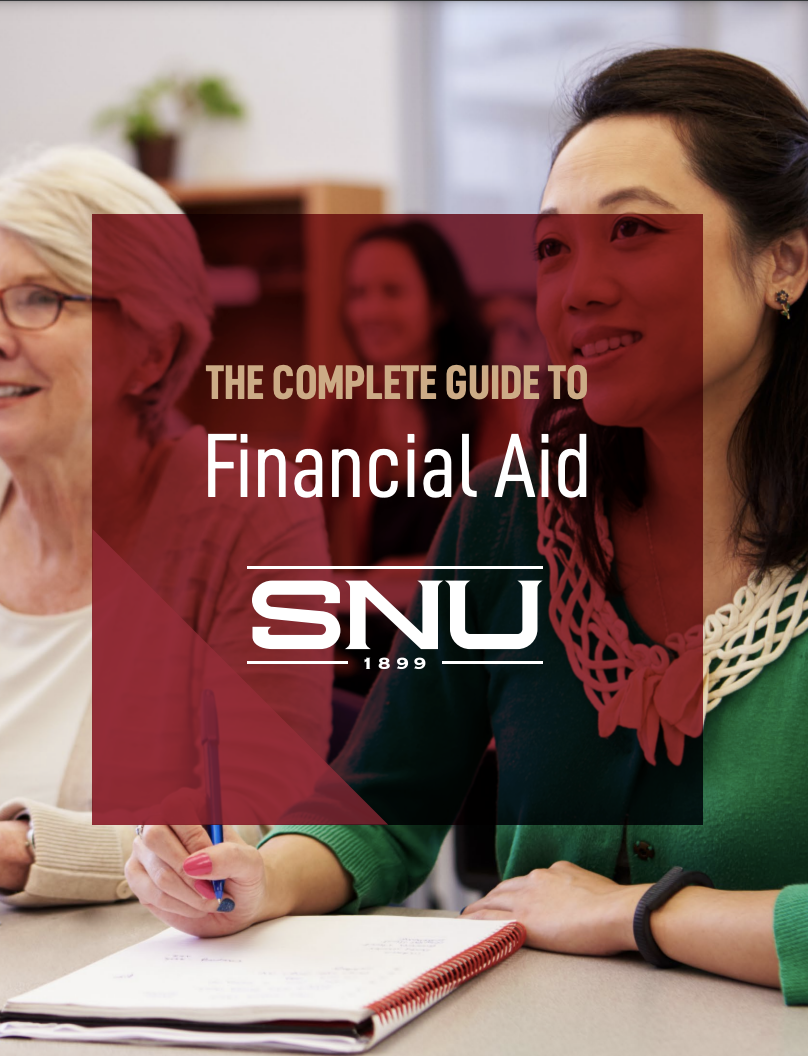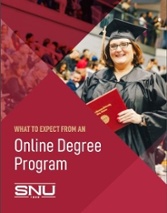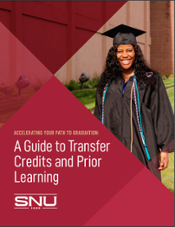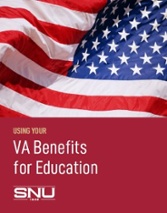-
Programs
Not Sure Where to Start?
- Associate Programs & Certificates
- General Studies
- Information Systems & Technology
- Physical Therapist Assistant
- Professional Services & Certificates
- View All
- Undergraduate Programs
- Business Administration
- Criminal Justice
- Cybersecurity
- Education
- Family Studies and Gerontology
- Healthcare Administration
- Organizational Leadership
- Accelerated General Education
- View All
- Resources
- Tuition & Aid
- Military
Financial Aid
When you enroll at SNU, we do everything we can to help you succeed. That begins with supporting you as you navigate the myriad of challenges associated with paying for your education.

How SNU Helps
Our financial aid office takes the guesswork out of applying for financial aid and will ensure you take full advantage of all the support that is available to you. We will meet with you either in-person or over the phone to help you:
Contact Us
Want help navigating the complexities of financial aid, assistance filling out your FAFSA, or have questions about getting started? Fill out the form to connect with our financial aid and receive personalized advice.
If you’d like to fill out your FAFSA on your own, SNU’s school code is 003149.

Have Other Questions About Financial Aid?
Get the answers to some of the most common questions about financial aid below.
Types of Financial Aid
How to Fill Out Your FAFSA
Which Type of Aid is Right for Me?
How Much Financial Aid Can I Get?
What Are My Repayment Options?
Other Helpful Resources and Links

Types of Financial Aid
Students can choose from a wide range of financial aid options if they begin their search early enough. Most financial aid packages fall into one of the following categories:
Grants
A grant is a financial award that does not have to be repaid. In general, grants must pay for the direct costs of school, such as tuition and fees, first. Thereafter, a student can use excess funds for living expenses.
The Federal Pell Grant is one of the best-known options. Students whose family income is less than $50,000 per year are eligible, with a maximum award of $7,395 for the 2023-2024 school year. To be eligible for a Pell Grant, you’ll have to fill out a Free Application for Federal Student Aid (FAFSA).
SNU’s school code is 003149.
You are not eligible for a Pell Grant if:
- You are currently incarcerated or are involuntarily civilly committed for a sexual offense.
- You have defaulted on a federal student loan, which means that you have not made payments for 270 days (or 330, if payments aren’t monthly). Students who rehabilitate or consolidate their loans by beginning a payment plan and making payments may still get the Pell Grant.
- You have received a full-time Pell Grant for more than 12 semesters.
- You are an undocumented immigrant.*
Part-time students are generally eligible for Pell Grants. The total award may be prorated to the number of course hours in which a student is enrolled.
The Oklahoma Tuition Aid Grant (OTAG) is a similar program for Oklahoma residents who attend eligible Oklahoma schools. This is a need-based grant, so the total award depends on a student’s family income. SNU students are eligible for an award of $1,300. Students must complete a FAFSA by December 1 of the year preceding enrollment to qualify for OTAG.
Please Note: Even if you miss the December 1 deadline, the state often extends it for a few weeks, so go ahead and complete your FAFSA as soon as after December 1 as possible.
While OTAG and Pell are popular options, there are dozens of other grants. Students who complete the FAFSA may also be eligible for the Federal Supplemental Educational Opportunity Grant. Local organizations, national associations, and private corporations may also offer grants. If you’re a member of an organization or part of a special interest group, consider beginning your grant search there.
Loans
A loan is a financial award that must be repaid. Although it’s possible to get a private loan from a bank or credit union, most students begin their loan search through the federal government, which offers a number of loans. Students with demonstrated financial need are eligible for federally subsidized loans.
Subsidized loans are loans that the federal government subsidizes so that they do not accrue interest while the student is in school. Unsubsidized loans do accrue interest, which means you may accumulate more debt. Unlike grants and scholarships, there are usually no limitations on how you spend the loan funds. The money is awarded directly to your student account. After you’ve paid for tuition and related direct educational expenses, you’ll be able to use additional funds as you see fit.
To begin your search for a federal loan, complete the FAFSA. You’ll receive information about which subsidized and unsubsidized loans you might be eligible for. Because subsidized loans are more affordable, only accept an unsubsidized loan when subsidized loans are insufficient to pay the total costs.
Federal loans offer many benefits, including a fixed interest rate that can prevent your debt from ballooning. Though interest rates vary from loan to loan and year to year, interest rates can vary, so check the current interest rates, fees, and repayment plans before taking a loan.
Note: Because of the COVID-19 pandemic, interest rates on federal student loans are temporarily set at 0 percent. Additionally, all current student loan borrowers have been placed in an administrative forbearance through January 31, 2022. This means borrowers are not required to make loan payments during this time, though they still can if desired.
To be eligible for a federal loan, you must:
- Be a U.S. citizen or eligible non-citizen; undocumented immigrants cannot get loans.*
- Meet certain financial need criteria to be eligible for subsidized loans.
- Meet certain academic requirements, such as being on track to complete your degree.
- Not be in default on student loans. If you are, you need to make payment arrangements before you can pursue additional loans. It is possible to cure student loan defaults, so students who think they may owe money should contact the Financial Aid Office for help addressing past-due loans.
- Not be incarcerated. Students with serious criminal records may have limited or no access to certain federal loans.
Federal loans are the superior option for most students. However, some students may not meet the eligibility requirements. Others may need more funds to cover tuition and other costs. If you hit the federal loan limit, you will also be unable to get more loans, even if you otherwise qualify.
Some students may be interested in using their loans to fund a second degree. As long as you otherwise meet financial aid requirements, you should be able to fund multiple degrees.
If federal loans don’t meet your financial needs or you are ineligible for such loans, you may be able to apply for a private loan. These loans function more like traditional loans. You’ll apply directly through a bank or credit union, and the award will be based on your credit, income, and similar criteria. These loans offer less favorable interest rates and terms, so max out your federal loan options before pursuing a private loan. Then research each loan provider to get the best possible terms.
Scholarships
Scholarships are financial awards that you do not have to repay. They’re usually based on academic merit or performance. In some cases, you might have to join an organization or be part of a specific group. For example, Oklahoma’s large indigenous population should explore tribal and American Indian scholarships. Some choices include:
- American Indian Education Foundation Scholarship
- American Indian College Fund Scholarship
- American Indian Graduate Center Wells Fargo Undergraduate Scholarships
Scholarships are generally contingent on specific academic results. You may need to maintain a certain GPA, take a predetermined number of classes each semester, or make sufficient progress toward graduation each year.
Assistantships and Work-Study
Assistantships offer a great opportunity to get involved at school while getting cash for college. Undergraduates can pursue campus jobs that allow them to work just a few doors away from their classes. Graduate students can often help fund the costs of their coursework with graduate teaching assistant roles.
For adult learners, jobs on campus may be impractical, especially when taking courses online. However, if this is something you’re interested in pursuing during your time at SNU, we do have several ongoing work-study jobs available throughout the year. These jobs offer valuable experience and may help you network with leaders in your field who might hire you when you graduate. You’re guaranteed at least the federal minimum wage of $7.25 per hour and receive direct deposit payments.
To be eligible for a work-study job, you must first complete the FAFSA and indicate that you are interested in the program. Fill out the form at the top of this page or call the Financial Aid office at (800) 648-9899 or (405) 491-6310 to discuss our open positions.
Employer Assistance Programs
Your return to school may offer tangible benefits to your employer. You’ll gain new skills, network with other professionals, and potentially bring useful ideas back to the office. Many employers, especially larger companies, recognize this value and offer tuition reimbursement programs. Ask your HR department about tuition assistance and whether you need to apply or pursue a specific degree to qualify.

How to Fill Out Your FAFSA
For students who choose to apply for federal financial aid, the process begins with completing a Free Application for Federal Student Aid (FAFSA).
The application asks about your current sources of income and requires details about your tax returns dating back two years. You’ll also need to answer questions about additional sources of funding, such as gifts from relatives.
To complete their FAFSA, most students need:
- A Social Security number or federal tax ID
- Your driver’s license number if you have a license
- Immigration documents if you are not a citizen
- Two years of tax returns
- Bank statements and details about any investments
- Records about any untaxed income
Steps to complete your FAFSA:
- Visit fafsa.gov.
- Create an account with the Department of Education to complete the application online and track its progress.
- Fill out the application using SNU’s school code 003149.
- Hint: If you use the IRS Data Retrieval tool, you can pre-fill your application with your latest federal tax return records. Not only will this save you time, it also prevents data entry mistakes that can delay the verification process.
- Create a Federal Student Aid ID.
- Submit!
Some students who complete FAFSA documents are selected for a verification process. When this happens, you must supply additional paperwork to your school’s financial aid office. In most cases, this paperwork will be the same paperwork you used to complete your FAFSA, such as tax returns or bank statements.
To apply for additional aid, such as scholarships, you may need similar information. You’ll also probably need copies of your previous college transcripts. Some scholarships require you to write an essay or complete an interview, so set aside time to finish the entire application well before the deadline.
For more information on how to fill out the FAFSA as a veteran student click here.

Which Type of Aid is Right for Me?
Many students returning to school mistakenly believe that they will not qualify for financial aid. This is especially common among adult learners who have previous academic debts or who have a history of student loan default.
Even if you have previously defaulted on a loan, you can become eligible for federal aid by entering loan rehabilitation or loan consolidation and making regular payments. And a federal loan default won’t necessarily affect your eligibility for private grants and scholarships.
Additionally, many adult students pursuing graduate degrees don’t realize that they also qualify for aid. Although most federal loans are in fact for undergraduate degrees, there are certain loans, such as the graduate PLUS loan and the Direct Unsubsidized Loan, that can also be used to fund graduate school.
You might worry that completing a FAFSA is too difficult or time-consuming. For most SNU students, the process is easy and straightforward. Our financial aid office can even help you complete the form in person or over the phone and assist you in figuring out how and where to get any supplemental materials the form might require, such as tax returns.
No single financial aid option works for every student. Some factors to weigh as you explore your options include:
- Debt. Many adult students already have debt from previous student loans, as well as mortgage, car, or credit card debt. Ensure you’re comfortable taking on more debt and can afford the monthly payments upon graduation, even if you end up in a job that doesn’t pay much more than your current role.
- Hidden costs. Some adults who can afford tuition out of pocket or who have access to employer assistance programs think they don’t need financial aid. Don’t be fooled. For returning students, higher education usually presents a number of hidden costs. You might have to pay for childcare, outsource some home management tasks, or take a pay cut at work for a more flexible schedule. The right student aid package can help you fund these costs.
- Academic requirements. If you qualify for a scholarship or for some grants, you may need to move at a specific speed toward your degree. Weigh whether this is realistic for you, given your current obligations.

How Much Financial Aid Can I Get?
The federal government limits the amount of aid each student can receive per year and in total. Need-based financial aid is limited to the total cost of attendance, which includes expenses like tuition and books, as well as room and board.
The amount of total aid you can get from a FAFSA application is also limited, though the limit changes each year. The limits are as follows:
- Pell Grant limit: $7,395 per year for the 2023-2024 academic year
- Federal Supplemental Educational Opportunity Grant: $500 per year at SNU for adult students
- Direct subsidized loan: $3,500 per year for freshmen; $4,500 per year for sophomores; $5,500 per year for upperclassmen; $23,000 aggregate total
- Direct unsubsidized: $5,500 per year for dependent freshmen; $12,500 per year for independent upperclassmen; $57,500 lifetime total, with no more than $23,000 of the total in subsidized loans
- Direct unsubsidized loans for graduate students: $20,500 per year; $138,500 lifetime total
Private loans do not have a consistent limit. Instead, your award may be limited by your credit and ability to repay the loan.
There is no legal limit on the amount of financial aid you can get when combining aid from different sources. This means that even if you hit the limit for financial aid from the federal government, you may still be eligible for private grants, employer tuition reimbursement, or scholarships. All types of loans and grants, with the exception of veteran benefits, are limited to the total estimated cost of attendance—a figure that includes direct costs such as tuition, books, and fees, as well as indirect expenses such as housing, transportation, and food.

What Are My Repayment Options?
Budgeting for student loans can prove difficult when you’re unsure how much money you’ll make in the future.
So err on the side of caution, taking out only as many loans as you need to fund your education. The U.S. Department of Education offers a wide range of loan repayment options. They include:
- A repayment estimator that will help you assess the total and monthly cost of your student loans.
- A graduated repayment plan starts low and increases over time, allowing you time to get a job and begin saving money.
- An extended repayment plan that can reduce monthly costs while still paying off your loans within 25 years.
- A Revised Pay as You Earn Repayment Plan (REPAYE), which structures payments according to your income. Your monthly costs will be no more than 10 percent of your discretionary income. Any amount you still owe after 20 years will be forgiven.
- An Income-Based Repayment Plan (IBR), which changes payments as your income changes. You’ll have to file income updates each year. A handful of other income-based plans have similar requirements.
- Student loan rehabilitation. This program for students who have defaulted allows them to repay their loans, repair their credit, and eventually become eligible for more student aid.

Other Helpful Resources and Links
The following links can make the student aid application process feel more manageable:
- Finaid.org offers a comprehensive guide to various types of student aid.
- The Bureau of Indian Education assists native students in finding appropriate aid.
- CollegeScholarships.org provides a student aid search engine, as well as information about a wide range of financial aid options.
- Studentaid.gov connects students to federal aid opportunities and help filling out a FAFSA.
- Fastweb.com was designed by the creators of Monster.com and features a comprehensive aid search engine.
- StudentLoans.gov educates students about various student loan options.
*Although undocumented students do not qualify for federal grants or loans, they may be eligible to receive state or college-funded aid. Learn more about financial aid options for undocumented students.
Download a PDF version of this guide by filling out the form









%20(2)-1.jpg?width=920&height=480&name=GettyImages-1143277379%20(1)%20(2)-1.jpg)

.jpg?width=2119&height=1414&name=GettyImages-693210204%20(1).jpg)
%20(1)%20(1).jpg?width=920&height=480&name=GettyImages-1168477592%20(1)%20(1)%20(1).jpg)

